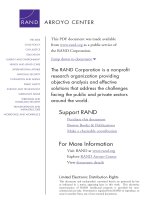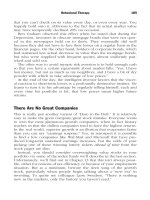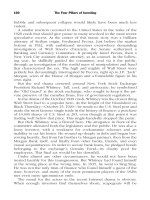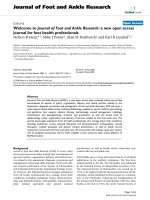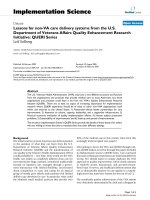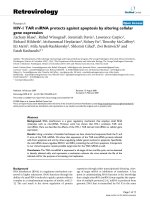Implementation Science Debate BioMed Central Open Access Lessons for non-VA care delivery systems pdf
Bạn đang xem bản rút gọn của tài liệu. Xem và tải ngay bản đầy đủ của tài liệu tại đây (210.92 KB, 4 trang )
BioMed Central
Page 1 of 4
(page number not for citation purposes)
Implementation Science
Open Access
Debate
Lessons for non-VA care delivery systems from the U.S.
Department of Veterans Affairs Quality Enhancement Research
Initiative: QUERI Series
Leif Solberg
Address: HealthPartners Medical Group and HealthPartners Research Foundation, Minneapolis MN, USA
Email: Leif Solberg -
Abstract
The U.S. Veterans Health Administration (VHA) may have a very different structure and function
from the organizations and practices that provide medical care to most Americans, but those
organizations and practices could learn a lot from the VHA's Quality Enhancement Research
Initiative (QUERI). There are at least six topics of increasing importance for implementation
research where QUERI experience should be of value to other non-VHA organizations, both
within and external to the United States: 1) Researcher-clinical leader partnerships for care
improvement; 2) Attention to culture, capacity, leadership, and a supportive infrastructure; 3)
Practical economic evaluation of quality implementation efforts; 4) Human subject protection
problems; 5) Sustainability of improvements; and 6) Scale-up and spread of improvements.
The articles in Implementation Science's QUERI Series provide the details of those lessons for others
who are willing to invest the time to translate them into their different settings.
Background
The initial reaction of most American care delivery leaders
to the question of what they can learn from the U.S.
Department of Veterans Affairs Quality Enhancement
Research Initiative (QUERI) and the transformation of
care quality in the Veteran's Health Administration (VHA)
would probably be – very little. Most would see the VHA
health care system as completely different from care for
most Americans: huge, national, centralized, traditionally
focused on inpatient care, managed through a govern-
ment bureaucracy with limited flexibility, unconcerned
about competition or costs, and caring for an atypical
group of mostly poor elderly male patients with limited
ability to go elsewhere for care. In particular, what could
the relatively small medical practices that provide over
80% of the medical care in this country learn from this
seemingly irrelevant giant care system?
After getting to know the VHA and QUERI through vari-
ous QUERI leaders as well as through the papers included
in Implementation Science's QUERI Series, I am convinced
that such preliminary impressions are understandable but
wrong. Few should expect to simply duplicate the VHA
approach to quality improvement, which clearly operates
in relatively arcane, bureaucratic, and acronym-encum-
bered ways. However, any healthcare delivery system that
can so dramatically improve its care quality in a surpris-
ingly short time must have lessons for the rest of us [1].
The remarkable quality achievements of the VHA system
were objectively demonstrated by Asch and colleagues in
Published: 26 February 2009
Implementation Science 2009, 4:9 doi:10.1186/1748-5908-4-9
Received: 22 August 2006
Accepted: 26 February 2009
This article is available from: />© 2009 Solberg; licensee BioMed Central Ltd.
This is an Open Access article distributed under the terms of the Creative Commons Attribution License ( />),
which permits unrestricted use, distribution, and reproduction in any medium, provided the original work is properly cited.
Implementation Science 2009, 4:9 />Page 2 of 4
(page number not for citation purposes)
their use of a variety of performance measures to compare
12 community samples with 12 VA systems [2]. Patients
from the VHA scored significantly higher for adjusted
overall quality (67% vs. 51%), chronic disease care (72%
vs. 59%), and preventive care (64% vs. 44%), but not for
acute care. Moreover, the "differences were greatest in
areas where the VHA has established performance meas-
ures and actively monitors performance." From the stand-
point of an external medical group willing to learn from
this experience, there are at least two important questions.
First, to what extent have the quality improvements been
due to QUERI versus other structural and process changes
implemented by VHA leadership? Other organizations
need to know both whether they must develop similar
research and operational partnerships for best results and
what management changes might be most beneficial.
One hint that QUERI may not be completely responsible
for the improvements comes from knowing that the
organizational changes began in 1995, and had already
accomplished much by the time that QUERI could have
had much effect by 2000 [1,3]. These changes included:
making it a primary organizational priority to produce
dramatic quality improvements, reorganizing care deliv-
ery into 22 regions or VISNs (Veterans Integrated Service
Networks), establishing quantitative performance meas-
urement metrics and using them to monitor comparisons
and accountability, aligning resource allocation with
quality goals, adopting system-wide practice guidelines,
and implementing electronic records and information
systems. Other answers could come from comparing per-
formance improvement for the eight topic areas created
by QUERI with others not so targeted but still part of the
VHA performance measurement set. So far as I can tell
from either the articles in the QUERI Series or those pub-
lished elsewhere, this has not been done. Thus, while it is
very tempting to believe that QUERI must have been
important in the VHA improvements for someone who
firmly believes that integrating research and practice is key
to real quality improvement in health care, none of the
articles in this Series prove that.
The other important question is which of the lessons from
QUERI do not depend on the unique characteristics of the
VHA? For example, lessons that should be applicable in
other care systems within or beyond the U.S. and medical
practices regardless of size. I have identified six important
issues where others should be able to take advantage of
the QUERI approach, even though they may not want,
need, or be able to adopt the QUERI model: 1)
Researcher-clinical leader partnerships for care improve-
ment; 2) Attention to culture, capacity, leadership, and a
supportive infrastructure; 3) Practical economic evalua-
tion of quality implementation efforts; 4) Human subject
protection problems; 5) Sustainability of improvements;
and 6) Scale-up and spread of improvements.
Discussion
Researcher-clinical leader partnerships
The first and most important issue addresses the large gap
or chasm separating what we think we know from what
we do in healthcare delivery, as highlighted by the Insti-
tute of Medicine in its landmark 2001 report [4]. Van de
Ven and Johnson have noted that this large gap between
theory and practice is not unique to medicine, but is com-
mon in most professions and businesses today [5]. They
discuss three alternative ways of viewing this gap.
1. Practice knowledge comes from research, so it is a
knowledge transfer problem. (It is usually described in
medicine as a problem of translation.)
2. Practice and research knowledge are different in nature,
each distinct and complementary, but not directly trans-
ferable to each other.
3. Production of useful knowledge is the real problem,
which requires what they call "engaged scholarship" and
research-practice partnerships.
In their view, the third concept is correct, and there are
very few examples of such partnerships in which the
agenda (research questions) comes from practice, and
both parties participate in developing, conducting and
implementing lessons from the research. That makes the
lessons from QUERI invaluable for other settings. Smith
et al describe how the Mental Health QUERI used partner-
ships to develop and evaluate the spread of evidence-
based collaborative care for depression [6]. While they
describe the approach being used that relies on participa-
tion and feedback by both researchers and VHA opera-
tional leaders, the formative evaluation hasn't been
completed, so it is too early to learn what worked and
what didn't. However, they observe that this kind of part-
nership creates a problem for health services researchers
by requiring a new role of them. Although new funding
mechanisms and organizational structures may be
required to permit this approach to thrive, we shall have
to await completion of the project to know what general-
izable lessons it produces.
In our large integrated care delivery system, we have inde-
pendently learned the importance of such research-prac-
tice partnerships, especially if the goal is practice
improvement rather than a one-way implementation of
research evidence. We have explored this approach with
other care delivery leaders elsewhere and find rather wide-
spread agreement with the need, although all of us are still
learning how to do it well [7]. Reading between the lines
Implementation Science 2009, 4:9 />Page 3 of 4
(page number not for citation purposes)
of QUERI description articles can help those working on
building partnerships.
Pay attention to culture, capacity, leadership, and a
supportive infrastructure
Stetler et al describe the framework and strategies used to
implement the QUERI approach to research-based prac-
tice [8]. They point out some of the main barriers and
facilitators that QUERI backers in the VHA had to address
in its implementation. Chief among these were three
interacting and overlapping elements for organizational
change that required leadership with clear expectations.
These also will need attention in any care setting: culture
change for both researchers and clinical care leaders; pro-
vision of capacity, capability, and resources; and support-
ive infrastructures to reinforce and sustain new behaviors
In our study of what is needed for transforming care in
large multi-specialty group practices, we identified similar
elements [9]. We also found those elements to be equally
important in a case study of an especially successful small
primary care practice [10]. A relatively simple conceptual
framework built on those and other research and organi-
zational change experiences in a wide variety of medical
practices may be easier for non-VHA practice leaders to
understand and use than the complex QUERI organiza-
tional framework, but the principles are very similar [11].
Practical economic evaluation of implementation
In the rest of the health care system, there is great concern
about the financial implications of any change, even if it
does result in improved quality. This problem becomes
especially complicated because current payment systems
often create misaligned incentives that benefit some par-
ties while hurting others. Current research approaches to
cost-effectiveness analysis are rarely used in decision-mak-
ing for many reasons [12]. Not least of these reasons is the
requirement by The Panel on Cost-Effectiveness in Health
and Medicine to focus on societal costs rather than those
of the parties who must charge and pay for the care [13].
QUERI economists Smith and Barnett have made an
important contribution to our ability to understand the
actual costs of medical business decisions by highlighting
business case analysis (BCA) and contrasting it with the
traditional cost effectiveness analysis (CEA) used by
researchers [14]. BCA has the advantage of separating the
costs of delivery from those of implementation, even sep-
arating the latter into the costs of initial engagement,
direct implementation, and indirect effects on health care
utilization. Most importantly, BCA takes the provider's
perspective, so it only counts those costs incurred by the
provider, and it does so over a short time horizon of 1–5
years rather than lifetime. Apparently this approach is
starting to be used widely in QUERI studies, including
using it as a tool to engage managers in the spread process.
While no actual examples are provided in the Smith
report, future reports on specific quality improvement
efforts using the BCA methodology should allow other
large care systems to understand the cost implications for
them.
Human subject protection problems
There is already considerable concern and confusion
about whether and how quality improvement (QI)
projects should be required to undergo formal review for
human subjects protection [15]. This is a particular prob-
lem when the results of a QI project warrant publication
for the benefit of other organizations, and the journal edi-
tor requires a statement confirming that the project had
institutional review board (IRB) approval. Since the cur-
rent IRB system requires prospective review, this catch-22
can prevent publication and actually damage the best
interests of patients. These problems and the time, effort,
and confusion caused by needing to work with multiple
IRBs for multi-site studies are clearly issues for QUERI, as
described by Chaney et al [16]. They describe quantita-
tively how their depression improvement evaluation
required 160 reports to multiple IRBs with varying
approaches and long time delays. If they succeed in facili-
tating movement toward centralized IRBs, a specific IRB
structure for QI projects, and clarification of guidelines for
implementation and QI research, it will be a very impor-
tant model for the rest of the world.
Sustainability of improvements
Leaders of large healthcare delivery organizations and
small practices alike know too well that sustaining suc-
cessful improvements is at least as hard as implementing
them in the first place. However, research studies rarely
either study this process or report on what happens after
the research team goes away, in part because of their lack
of interest in this problem and in part because of the con-
straints of funding. While the report of Bowman et al sug-
gests that the funding problem for QUERI evaluations is
as important in the VHA as elsewhere, the organizational
priority for maintaining change seems likely to produce
information about this problem [17]. They describe a sup-
plemental study of a QUERI program to improve HIV/
Hepatitis care that developed measures of continued use
of new care processes and outcomes. They found it impor-
tant to distinguish between maintenance failures caused
by external influences versus internal lack of perceived
utility. The most important lesson of their study was the
need to have measures of sustainability built into the orig-
inal project rather than as a post hoc add-on. They recom-
mend that research funders require sustainability analyses
and note that was part of a 2005 VHA project solicitation.
While funding support for more complex sustainability
measures may not be likely or seem relevant for small or
Publish with BioMed Central and every
scientist can read your work free of charge
"BioMed Central will be the most significant development for
disseminating the results of biomedical research in our lifetime."
Sir Paul Nurse, Cancer Research UK
Your research papers will be:
available free of charge to the entire biomedical community
peer reviewed and published immediately upon acceptance
cited in PubMed and archived on PubMed Central
yours — you keep the copyright
Submit your manuscript here:
/>BioMedcentral
Implementation Science 2009, 4:9 />Page 4 of 4
(page number not for citation purposes)
large practices doing their own quality improvement ini-
tiatives, the concept is still important. Any size group can
identify a few key process or outcome measures of desired
improvements that are simple enough to be repeated peri-
odically and monitored on a time chart. Learning to rely
on such data is an important part of becoming a learning
organization, just like QUERI has helped the VHA to
become [18].
Dissemination and spread of improvements
A related aspect of improvement implementation that is
usually neglected in the current literature is scale-up and
spread of successful projects. Again, the national scope of
the VHA makes it very important to address and solve this
issue, but it is also a problem for most multi-site care sys-
tems. In an ongoing QUERI study, Luck and colleagues
examine the Mental Health QUERI Center's use of a social
marketing approach to reach the various audiences
important to spread: national and VISN leaders, facility
managers, clinicians, and veterans. Although their work is
an effort in progress, its delineation of strategies for differ-
ent target audiences may be useful for others. Berwick has
described this scale-up/spread problem, identifying seven
recommendations for accelerating the diffusion of inno-
vations, and they sound a lot like the lessons from QUERI
[19].
Summary
Although the administrative and scope characteristics of
the VHA make many of the specific answers to the issues
described above irrelevant to even large healthcare deliv-
ery organizations in the U.S., the issues themselves and
generic lessons from QUERI are important for any size
care system or clinic anywhere. That importance and its
relevance will be clearer if QUERI authors publish their
findings in language and styles that are equally relevant to
those audiences. That has not been particularly true of
most of the articles in this Series, which seem primarily
aimed at those within the VHA and QUERI. Some previ-
ous articles have provided better examples of such an
approach, especially those of Rubenstein and Pugh for
implementation researchers and of Hagedorn et al for
anyone implementing research evidence into clinical
practice [20,21]. However, QUERI has much to teach
those who are willing to work at translating its now exten-
sively published lessons into usable ideas for their set-
tings, no matter how different those settings may seem to
be.
Competing interests
The author declares that they have no competing interests.
References
1. Kizer KW, Demakis JG, Feussner JR: Reinventing VA health care:
systematizing quality improvement and quality innovation.
Med Care 2000, 38:I7-16.
2. Asch SM, McGlynn EA, Hogan MM, Hayward RA, Shekelle P, Ruben-
stein L, Keesey J, Adams J, Kerr EA: Comparison of quality of care
for patients in the Veterans Health Administration and
patients in a national sample. Ann Intern Med 2004, 141:938-945.
3. Kizer KW: The "new VA": a national laboratory for health
care quality management. Am J Med Qual 1999, 14:3-20.
4. Institute of Medicine: Crossing the quality chasm: A new health system for
the 21st century Washington DC: National Academy Press; 2001.
5. Ven A Van de, Johnson PE: Knowledge for theory and practice.
Acad Mgmt Rev 2006, 31:.
6. Smith JL, Williams JW, Owen RR, Rubenstein LV, Chaney E: Devel-
oping a national dissemination plan for collaborative care for
depression: QUERI Series. Implement Sci 2008, 3:59.
7. Kottke TE, Solberg LI, Nelson AF, Belcher DW, Caplan W, Green
LW, Lydick E, Magid DJ, Rolnick SJ, Woolf SH: Optimizing practice
through research: a new perspective to solve an old prob-
lem. Ann Fam Med 2008, 6:459-462.
8. Stetler CB, McQueen L, Demakis J, Mittman BS: An organizational
framework and strategic implementation for system-level
change to enhance research-based practice: QUERI Series.
Implement Sci 2008, 3:30.
9. Solberg LI, Taylor N, Conway WA, Hiatt RA: Large multispecialty
group practices and quality improvement: what is needed to
transform care? J Ambul Care Manage 2007, 30:9-17.
10. Solberg LI, Hroscikoski MC, Sperl-Hillen JM, Harper PG, Crabtree BF:
Transforming medical care: case study of an exemplary,
small medical group. Ann Fam Med 2006, 4:109-116.
11. Solberg LI: Improving Medical Practice: A Conceptual Frame-
work. Ann Fam Med 2007, 5:251-256.
12. Neumann PJ: Why don't Americans use cost-effectiveness
analysis? Am J Man Care 2004, 10:308-312.
13. Russell LB, Gold MR, Siegel JE, Daniels N, Weinstein MC: The role
of cost-effectiveness analysis in health and medicine. Panel
on Cost-Effectiveness in Health and Medicine. JAMA 1996,
276:1172-1177.
14. Smith MW, Barnett PG: QUERI and the economics of imple-
mentation studies. Implement Sci 2008, 3:20.
15. Wolf LE, Walden JF, Lo B: Human subjects issues and IRB
review in practice-based research. Ann Fam Med 2005, 3(Suppl
1):S30-37.
16. Chaney E, Mittman D, Uman J, Rabuck LG, Simon B, Simons C, Ritchie
M, Cody M, Rubenstein LV: Human subjects protection issues in
QUERI implementation research. Implement Sci 2008, 3:10.
17. Bowman CC, Sobo EJ, Asch SM, Gifford AL, the HIV/Hepatitis Quality
Enhancement Research Initiative: Measuring persistence of
implementation: QUERI Series. Implement Sci 2008, 3(1):21.
18. Senge PM: The fifth discipline: the art & practice of the learning organiza-
tion New York: Currency Doubleday; 1990.
19. Berwick DM: Disseminating innovations in health care. JAMA
2003, 289:1969-1975.
20. Hagedorn H, Hogan M, Smith JL, Bowman C, Curran GM, Espadas D,
Kimmel B, Kochevar L, Legro MW, Sales AE: Lessons learned
about implementing research evidence into clinical practice.
Experiences from VA QUERI. J Gen Intern Med 2006, 21(Suppl
2):S21-24.
21. Rubenstein LV, Pugh J: Strategies for promoting organizational
and practice change by advancing implementation research.
J Gen Intern Med 2006, 21(Suppl 2):S58-64.
